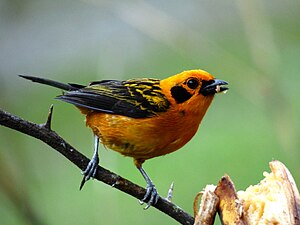Golden tangar
| Golden tangar | ||||||||||||
|---|---|---|---|---|---|---|---|---|---|---|---|---|

Golden tangar ( Tangara arthus ) in Colombia |
||||||||||||
| Systematics | ||||||||||||
|
||||||||||||
| Scientific name | ||||||||||||
| Tangara arthus | ||||||||||||
| Lesson , 1832 |
The Golden Tanager ( Tangara arthus ) is a native to South America bird art from the family of tanagers (Thraupidae). It lives in the tropical and subtropical rainforests from northern Venezuela to northern Bolivia .
It is classified as not at risk (“least concern”).
features
Gold tangars reach a body length of slightly more than 13 cm and weigh up to 22 grams. The head is colored golden yellow with a narrow black area around the beak. There is a trapezoidal black spot on each of the ear covers. The upper back is dashed black, the lower back and the rump are golden yellow. The wings and tail are mostly black, the wings lined with green at the edges. The iris is brown to dark brown. The beak of adult birds is black. The legs are black, gray, or bluish gray. The females resemble the males. The plumage of the young birds is grayer, the ear covers appear featherless, the black spot is missing. The beak and legs of the young birds are gray.
Geographic variation
Nine subspecies are recognized:
- Tangara arthus aequatorialis ( Taczanowski & Berlepsch ) 1885 - Eastern slope of the Andes of Ecuador and adjacent north of Peru .
- Tangara arthus arthus Lesson 1832 - Mountains of North and West Venezuela .
- Tangara arthus aurulenta ( Lafresnaye ) 1843 - Sierra de Perijá in northwestern Venezuela and western slope of the eastern Andes of Colombia .
- Tangara arthus goodsoni Hartert 1913 - western slope of the Andes of Ecuador and possibly northwestern Peru.
- Tangara arthus occidentalis Chapman 1914 - western slope of the central Andes and both sides of the western Andes in Colombia.
- Tangara arthus palmitae Meyer de Schauensee 1947 - Western slope of the eastern Andes near La Palmita in the Santander department , Colombia.
- Tangara arthus pulchra ( Tschudi ) 1844 - Eastern slope of the Andes of Peru.
- Tangara arthus sclateri ( Lafresnaye ) 1854 - Both slopes of the eastern Andes of Colombia and possibly in the Andes of the adjacent southwestern Venezuela.
- Tangara arthus sophiae ( Berlepsch ) 1901 - Eastern slope of the Andes of southeastern Peru and south to Bolivia.
The underside varies from yellow to brownish depending on the subspecies and distribution area. From the chest across the bottom to the coverts to recover from the nominate form a broad, maroon ribbon. The yellow at T. a. aurulenta is a little paler, the underside is a solid golden yellow. At T. a. aequatorialis , throat and chest are washed out red-brown to yellow-brown, in T. a. pulchra and T. a. sophiae , the hue is clearer on the throat and chest. The underside of T. a. sclateri is uniformly reddish brown in color. At T. a. goodsoni , the underside is less golden than that of T. a. aurulenta , the rump clearly yellow. T. a. palmitae is T. a. aurulenta and T. a. similar to goodsoni . The underside is paler, the stripes on the back are yellow-green. Also T. a. occidentalis is similar to T. a. aurulenta , but the underside is more colorful.
distribution
The distribution area includes the coastal mountains from eastern Falcón to Miranda and the Andean slope in Venezuela , Colombia , Ecuador , eastern Peru and north-western Bolivia . The golden tangar occurs mostly at altitudes of 700 to 2500 m. It is most common below 1500 m, locally it can be found up to sea level.
Way of life
Golden tangars usually live in pairs or small groups and almost always socialize with other species of tanagers. The habitat is in mountain rainforests and on forest edges. The species feeds on fruits, berries (such as those of the black-mouthed family ) and insects that they typically look for on mossy branches. They find their food in the middle of the tree up to the treetops. The nest is built on mossy branches and can be worked into the moss. The clutch consists of one or two eggs which are incubated for 10 to 15 days. Several adult birds take care of the young, the food consists of fruits and arthropods .
Individual evidence
- ↑ a b c d e Steven L. Hilty: Birds of Venezuela. Princeton University Press, 2002, ISBN 0-691-09250-8 , p. 789.
- ^ A b c d Robert S. Ridgely, Guy Tudor: Field Guide to the Songbirds of South America: The Passerines. University of Texas Press, 2009, ISBN 978-0-292-71979-8 , p. 388.
- ↑ Tangara arthus in the IUCN Red List of Threatened Species 2010.4. Listed by: BirdLife International, 2009. Retrieved June 2, 2011.
- ↑ a b c JL Cameron, KJ Burns: Golden Tanager (Tangara arthus). Neotropical Birds Online (TS Schulenberg, Editor). Cornell Lab of Ornithology, Ithaca. (on-line)
- ↑ Videos, photos and sound recordings for Golden Tanager (Tangara arthus) in the Internet Bird Collection
- ^ Thomas S. Schulenberg: Birds of Peru. Princeton University Press, 2010, ISBN 978-0-691-13023-1 , p. 562.
- ^ A b Robert S. Ridgely, Guy Tudor, William L. Brown: The Birds of South America: The Oscine Passerines. University of Texas Press, 1989, ISBN 0-292-70756-8 , p. 234.
Web links
- Tangara arthus inthe IUCN Red List of Threatened Species 2011.2. Listed by: BirdLife International, 2009. Retrieved April 1, 2012.
- BirdLife International: Species Factsheet - Golden Tanager ( Tangara arthus ) . Retrieved April 1, 2012.
- Videos, photos and sound recordings for Golden Tanager (Tangara arthus) in the Internet Bird Collection
- Goildtangare ( Tangara arthus ) at Avibase; Retrieved April 1, 2012.
- Tangara arthus in the Integrated Taxonomic Information System (ITIS). Retrieved April 1, 2012.
- xeno-canto: sound recordings - Golden Tanager ( Tangara arthus )